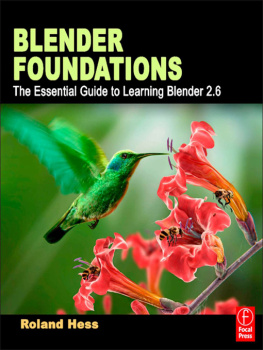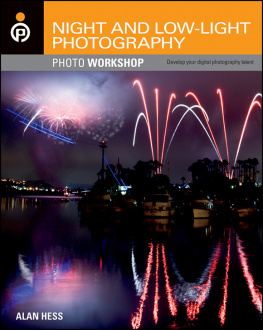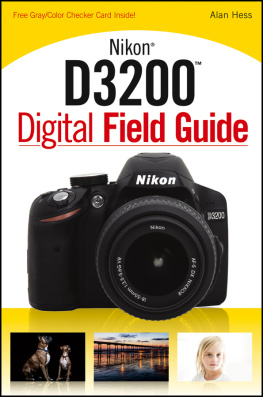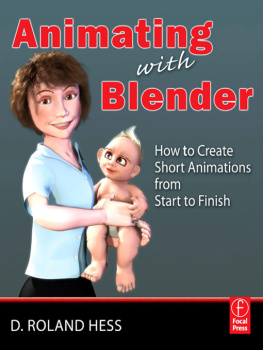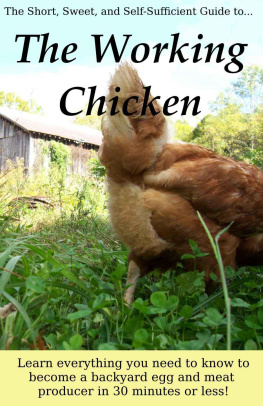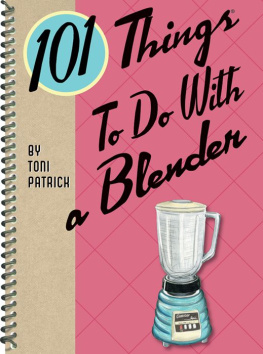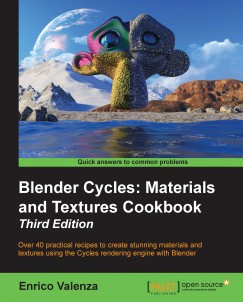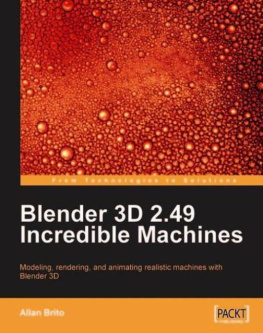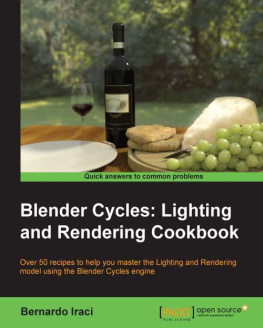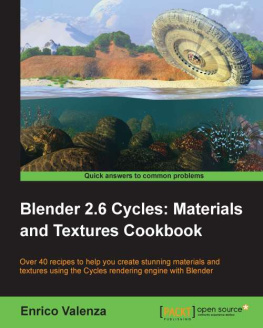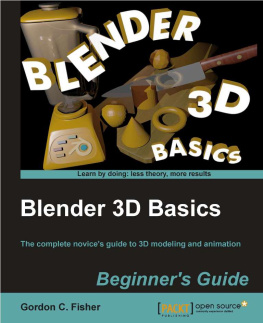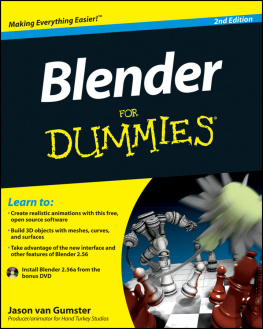Hess - Blender Foundations: the Essential Guide to Learning Blender 2.5
Here you can read online Hess - Blender Foundations: the Essential Guide to Learning Blender 2.5 full text of the book (entire story) in english for free. Download pdf and epub, get meaning, cover and reviews about this ebook. City: Independence, year: 2013, publisher: Taylor and Francis; CRC Press, genre: Home and family. Description of the work, (preface) as well as reviews are available. Best literature library LitArk.com created for fans of good reading and offers a wide selection of genres:
Romance novel
Science fiction
Adventure
Detective
Science
History
Home and family
Prose
Art
Politics
Computer
Non-fiction
Religion
Business
Children
Humor
Choose a favorite category and find really read worthwhile books. Enjoy immersion in the world of imagination, feel the emotions of the characters or learn something new for yourself, make an fascinating discovery.
- Book:Blender Foundations: the Essential Guide to Learning Blender 2.5
- Author:
- Publisher:Taylor and Francis; CRC Press
- Genre:
- Year:2013
- City:Independence
- Rating:5 / 5
- Favourites:Add to favourites
- Your mark:
- 100
- 1
- 2
- 3
- 4
- 5
Blender Foundations: the Essential Guide to Learning Blender 2.5: summary, description and annotation
We offer to read an annotation, description, summary or preface (depends on what the author of the book "Blender Foundations: the Essential Guide to Learning Blender 2.5" wrote himself). If you haven't found the necessary information about the book — write in the comments, we will try to find it.
Hess: author's other books
Who wrote Blender Foundations: the Essential Guide to Learning Blender 2.5? Find out the surname, the name of the author of the book and a list of all author's works by series.
Blender Foundations: the Essential Guide to Learning Blender 2.5 — read online for free the complete book (whole text) full work
Below is the text of the book, divided by pages. System saving the place of the last page read, allows you to conveniently read the book "Blender Foundations: the Essential Guide to Learning Blender 2.5" online for free, without having to search again every time where you left off. Put a bookmark, and you can go to the page where you finished reading at any time.
Font size:
Interval:
Bookmark:

You may be under the impression that working in 3D is an attempt to create the real world inside of your computer. Its a tempting and logical thoughtthe world itself is 3D. It consists of objects that have a certain form, the surfaces of which have properties that make them appear a certain way, and of light that allows us to see the whole thing. We can create form, surface, and light inside of a computer, so wouldnt the best approach just be to make everything inside the computer as close to the way it is in the real world and be done with it?
It turns out the answer is noaccurately simulating the world is not the best approach. That way madness lies.
We all live in the world. We know what it looks, smells, sounds, and feels like. More importantly though, we know what it looks like when carefully lit and shot through a lens by a skilled photographer. It is through two-dimensional (2D) images, either still or animated, that people will experience our 3D work, and this is the target we should be working toward. It turns out that this makes our job as a 3D artist both easier and harder than the job of someone who is mistakenly attempting to simulate the world. Its easier because, well, the world is stupifyingly large and deceptively complex. Its harder because there are considerations other than concrete sensory input (i.e., A tree is shaped like this , feels that , and acts thusly ), and considerations like what is and is not seen in the final image, and at what level of detail: how it all goes together; how it demonstrates what you are trying to say; composition; art, even.
To be good at 3D creation, you will need to develop a facility for carefully observing the world around you, extracting those elements that will best contribute to your image and leaving the rest out. You will be creating a simulation of the real world that is specifically targeted at producing a final imagea unique virtual mini-world of which the sole purpose for existence is to create the illusion of reality in 2D that we experience when looking at a picture or watching a movie.
Lets take a look at the different elements of a real scene that we will need to analyze and rebuild in order to achieve this.
Everything that we see has a forma physical structure. We know what these forms are: how a lion is shaped, what it looks like when pudding falls on the floor, the essence of a chair.
The essence of a chair?
Well, what is a chair, anyway? There are thousands of different kinds of chairs, but when we see one, we know its a chair. Thats because although the details differ, the form generally remains the same: a place to rest your back side, some means of support (usually legs, but it doesnt have to be), and a back. If theres no back, its a stool. And so when we see an overstuffed recliner, a swivel chair attached to a table in a fast food place, or just a basic dining room Queen Annestyle chair, our brain identifies the form and tells us chair.
It is form that lets us know what things are. In the real world, form is made from matter. Yes, thats matter, as in solid/liquid/gas from science. I know that no one said there would be science here, but there is, as well as mathget used to it.
A lions form is made up of organs, bone, muscle, skin, and fur. Pudding is made from milk, gelatin, and, hopefully, chocolate. A chairs form is constructed of any number of things, including wood, metal, and plastic. However, none of the insides really matter to our perception of the form. In general, we only see the outer surface, and that is enough for us to properly identify things.
This is the first place that we decide as 3D artists that we will not simulate the world as it is, but as we would see it through a lens. With a few exceptions, a camera only sees the outside surfaces of objects, so that is all that we need to worry about. If we want to create images of forms (pictures of stuff for the layman) we can temporarily forget about what things are made of and just focus on the shape of their surface.
In 3D, surfaces are built from polygons , specifically triangles and quadrangles in Blenders case ().
Figure 1.1 A scene created from polygons.

Figure 1.2 Vertex, edge, and face.
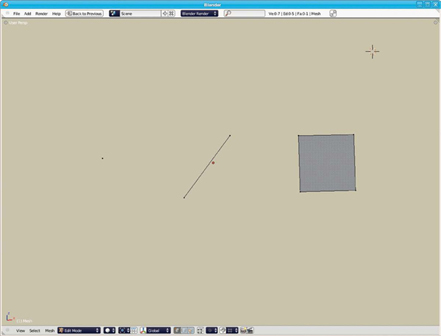
These polygons are created and linked together in clever (or not-so-clever) ways until the whole surface of a form is constructed. This construction is called a model . When making models in 3D, it is important to keep in mind how their form will be shown in the final image. If the image of the object will be very small, perhaps because it is far in the distance or just a tiny detail like a flea or a grain of sugar, the model can be very simple (). There would be no need to create a model of a building in exhaustive detail if it appeared only one-quarter inch high on a distant hillside in the final image.
Figure 1.3 A landscape with a building in the distance.
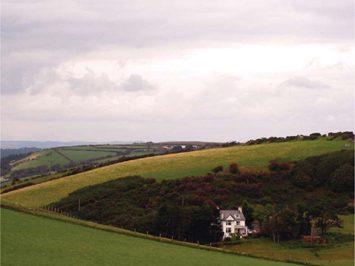
(Photograph by alexanderwar12/Al, Creative Commons Attribution-Share Alike 2.0 Generic.)
We know what the form of such a building is in the real world. It has a roof, a chimney, windows with trim, maybe a spigot for a hose, and many other details. However, when we look at the 2D image with a critical eye, we can see that for our purposes, the building is little more than a box with a triangular ).
Figure 1.4 A basic model of a building for use in the distance.
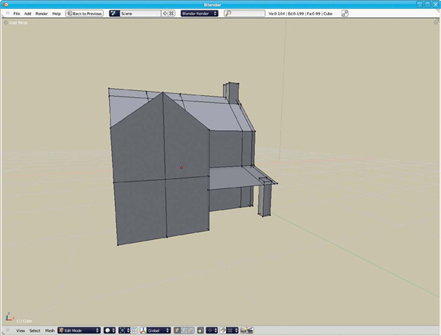
Obviously, if this same building were the main subject of the image, shown close up, its form in the image would be drastically different, and we would model it differently (). In fact, depending on the image we are trying to achieve, we might only create a model of a portion of the building. If the image consisted of a close-up shot of the exterior of the building, we might choose to only model that part of the building that shows on camera.
Figure 1.5 The project scenethe forms are obvious.
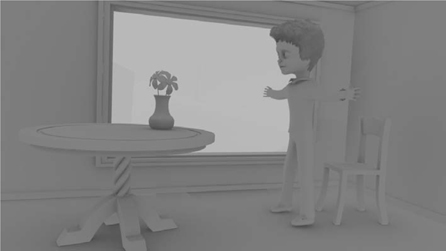
In 3D, models that are made of polygons are our forms. They tell us what we are looking at. As a final example, take a look at the scene project for this book, without any texturing or lighting. It is only the forms, yet we know immediately what everything is. Clearly, though, none of this stuff is real, could be mistaken for real, or is even believable. Thats because believability comes not from form, but from surfacing and lighting.
Surfacing refers to the way that surfaces look. Once again, we can examine the real world to learn a few things. We know what wood looks like. However, it looks different when its part of a tree, freshly cut, or stained and finished in a piece of furniture. Each of these surfaces have different visual properties. A tree is roughthe bark is generally a brownish gray, rough, occasionally covered with moss or lichen. Cut wood is often light (excepting things like walnut, of course) with a pattern of concentric circles. It is generally smooth, although if you look closely you can see a pattern of grain. Finished wood that is part of a piece of furniture can be many colors; for example, it can be extremely smooth and highly reflective, in the case of a grand piano.
Font size:
Interval:
Bookmark:
Similar books «Blender Foundations: the Essential Guide to Learning Blender 2.5»
Look at similar books to Blender Foundations: the Essential Guide to Learning Blender 2.5. We have selected literature similar in name and meaning in the hope of providing readers with more options to find new, interesting, not yet read works.
Discussion, reviews of the book Blender Foundations: the Essential Guide to Learning Blender 2.5 and just readers' own opinions. Leave your comments, write what you think about the work, its meaning or the main characters. Specify what exactly you liked and what you didn't like, and why you think so.

